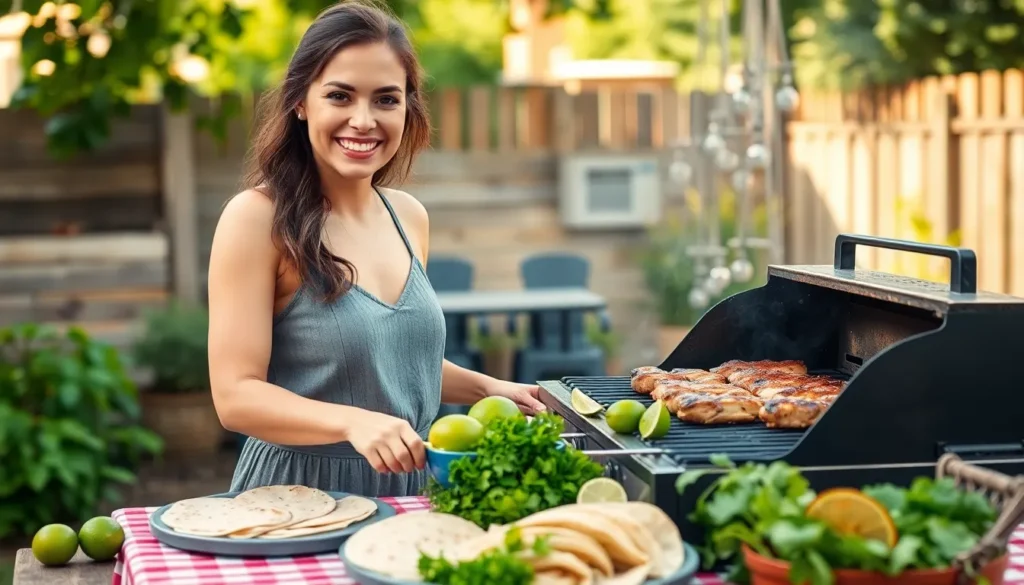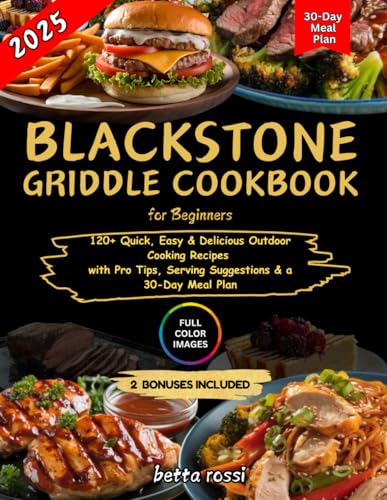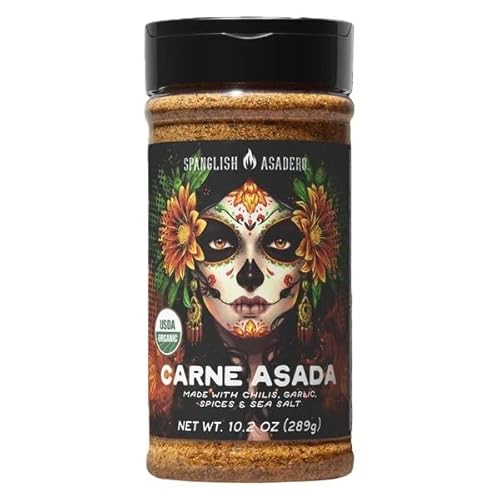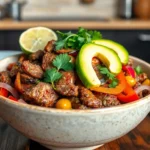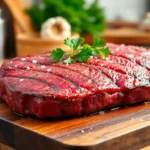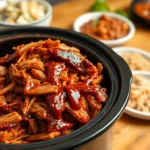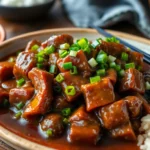Carne asada brings the vibrant flavors of Mexican street food straight to your backyard grill. This beloved dish transforms simple skirt or flank steak into tender juicy perfection through the magic of citrus marinades and high-heat cooking. We’ve perfected this recipe to deliver that authentic charred exterior and succulent interior that makes carne asada irresistible.
The secret lies in our carefully balanced marinade that tenderizes the meat while infusing it with bold flavors of lime garlic and spices. Whether you’re planning a weekend barbecue or craving restaurant-quality Mexican food at home this recipe delivers every time.
Perfect for tacos burritos or simply served with warm tortillas our carne asada recipe creates memorable meals that’ll have your family and friends asking for seconds. The best part? It’s surprisingly simple to make and requires just a few hours of marinating time before hitting the grill.
What Is Carne Asada
Carne asada translates to “grilled meat” in Spanish and represents one of Mexico’s most beloved culinary traditions. We define this dish as marinated beef that gets cooked over high heat to achieve a perfect balance of smoky char and tender interior. The preparation typically uses cuts like skirt steak or flank steak that benefit from the tenderizing effects of citrus-based marinades.
Traditional carne asada originated in northern Mexico where ranchers would grill beef over open flames after long days of cattle work. We see this cooking method spread throughout Mexican and Tex-Mex cuisine where it became a staple for street food vendors and family gatherings. The dish gained popularity across the southwestern United States and now appears on menus from food trucks to upscale restaurants.
Key characteristics distinguish authentic carne asada from other grilled beef preparations. We notice the meat gets cut against the grain into thin strips that maximize tenderness. The marinade always includes citrus elements like lime or orange juice that break down tough fibers while infusing bright flavors. High heat cooking creates the signature charred exterior that contrasts beautifully with the juicy pink interior.
Most carne asada recipes call for affordable cuts that transform into restaurant-quality meals through proper marinating and grilling techniques. We appreciate how skirt steak and flank steak absorb marinades quickly due to their loose grain structure. These cuts also cook fast over direct heat making them perfect for weeknight dinners or weekend barbecues.
The versatility of carne asada makes it suitable for many serving styles. We enjoy it tucked into warm tortillas for tacos or wrapped in larger flour tortillas for burritos. The sliced beef also works well over rice bowls or alongside grilled vegetables for a complete meal.
Essential Equipment and Tools

Having the right equipment transforms our carne asada preparation from good to exceptional. We recommend gathering these essential tools before starting to ensure smooth cooking and professional results.
Meat Mallet or Heavy Object serves as our first essential tool for achieving tender, evenly cooked steak. We use this to pound the steak to uniform thickness, which ensures consistent cooking throughout and prevents tough, chewy spots.
Large Sealable Bag or Container becomes our marinade vessel for thorough flavor penetration. We prefer using heavy-duty freezer bags that allow us to massage the marinade into every surface of the meat while keeping our kitchen clean.
Whisk or Large Spoon helps us blend our marinade ingredients into a cohesive mixture. We need this tool to properly emulsify the citrus juices, oil, and spices for maximum flavor impact.
Instant-Read Thermometer provides precision when monitoring doneness levels. We strongly recommend this tool for achieving perfect results, whether grilling outdoors, cooking on the stovetop, or using the oven method.
Grill or Grill Pan delivers the authentic smoky flavor that makes carne asada special. We prefer outdoor grills for their high heat capabilities, though a cast iron grill pan works excellently as an indoor alternative.
Tongs allow us to flip and maneuver the steak without piercing the meat. We avoid forks or other sharp utensils that release precious juices during the cooking process.
Sharp Knife and Cutting Board complete our essential setup for the final slicing stage. We need a quality knife to cut thin slices against the grain, which ensures maximum tenderness in every bite.
| Tool | Primary Function | Why Essential |
|---|---|---|
| Meat Mallet | Tenderizing | Ensures even thickness and cooking |
| Sealable Bag | Marinating | Maximizes flavor penetration |
| Instant-Read Thermometer | Temperature monitoring | Prevents overcooking |
| Grill/Grill Pan | High-heat cooking | Creates authentic char and flavor |
| Sharp Knife | Slicing | Proper grain cutting for tenderness |
These tools work together to create restaurant quality carne asada at home. We find that investing in proper equipment pays off with consistently delicious results that capture the authentic flavors of this beloved Mexican dish.
Ingredients
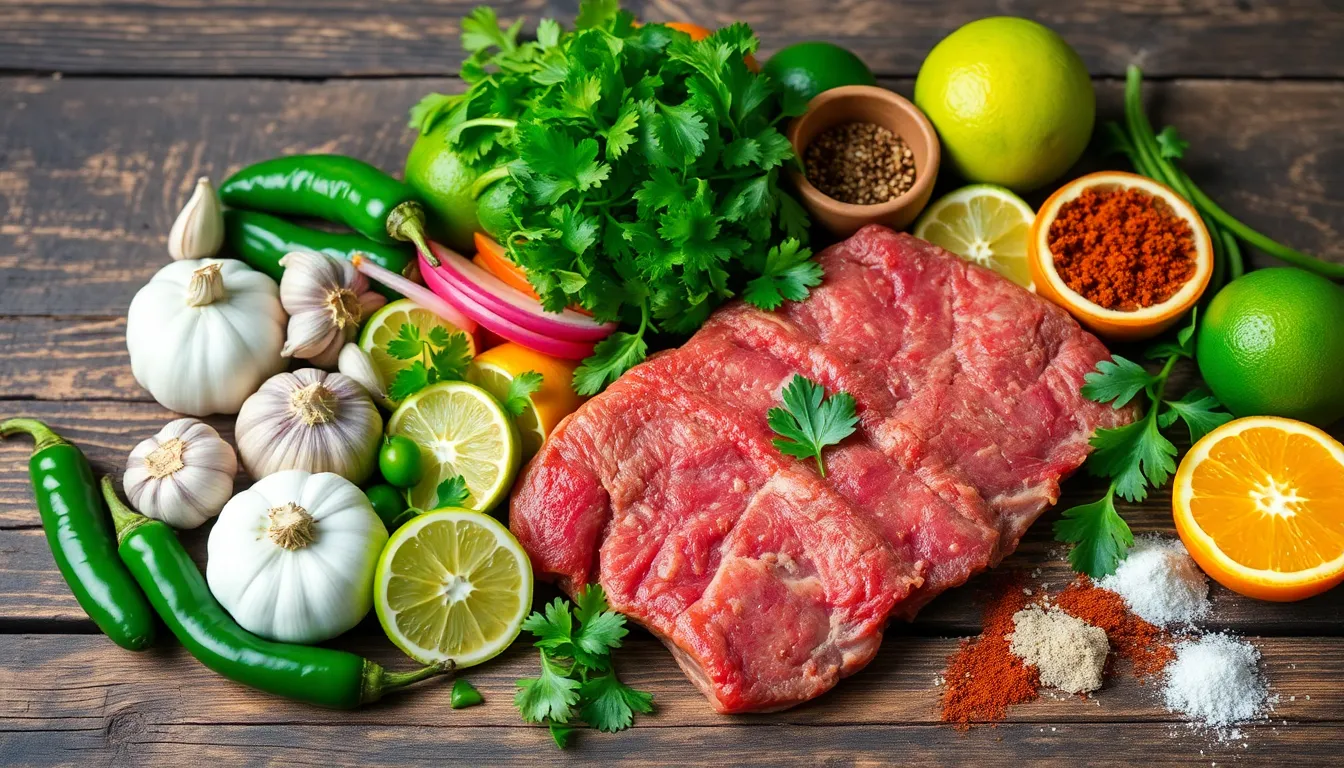
We’ll need three main categories of ingredients to create authentic carne asada that delivers bold Mexican flavors. Our carefully selected ingredients work together to create the perfect balance of citrus brightness and smoky heat.
For the Marinade
Fresh Aromatics:
- 1 jalapeño, seeded and minced
- 4 cloves garlic, minced
- 1/2 cup fresh cilantro leaves, chopped
- 1 peeled onion, roughly chopped
Citrus Components:
- Juice of 1 orange
- Juice of 1 lime
- Juice of 1 lemon
- Zest of orange and lime
Liquid Base:
- 1/3 cup olive oil
- 2 tablespoons apple cider vinegar
- 1 cup light beer
- 1/4 cup soy sauce
Spices and Seasonings:
- 1 teaspoon ground cumin
- 1 teaspoon cumin seeds
- 1 teaspoon kosher salt
- 1/4 teaspoon freshly ground black pepper
- 2 chipotle peppers (optional for smoky heat)
For the Beef
- 2 pounds skirt steak or flank steak, trimmed of excess fat
Both cuts are traditional choices that absorb marinades exceptionally well and deliver tender results when sliced against the grain.
For Serving
Essential Accompaniments:
- Fresh lime wedges
- Chopped fresh cilantro
- Sliced white onions
- Corn or flour tortillas
- Fresh salsa
- Guacamole
- Additional taco toppings of choice
Marinade Preparation
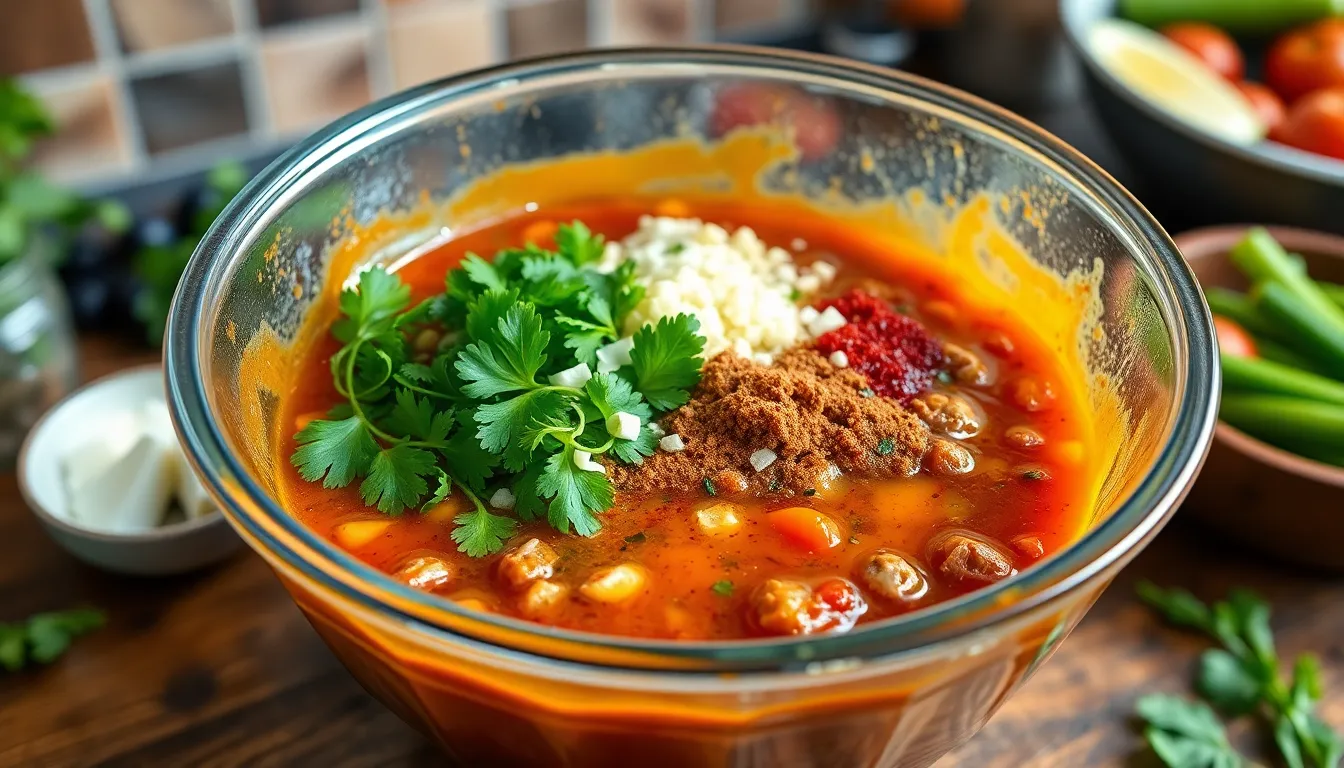
We begin creating our carne asada marinade by whisking together all the liquid ingredients in a large mixing bowl. The combination of citrus juices, olive oil, and soy sauce forms the foundation that will tenderize and flavor our beef. Fresh lime juice provides the primary acid component, while orange juice adds natural sweetness to balance the tanginess.
Our next step involves incorporating the aromatic elements that give carne asada its distinctive character. We mince four garlic cloves and add them to our citrus base along with the chopped fresh cilantro. The cilantro should be roughly chopped to release its oils without turning to mush during the marinating process.
Spices get whisked in one at a time to ensure even distribution throughout the marinade. We add ground cumin first, followed by chili powder, then black pepper and salt. Each spice contributes to the complex flavor profile that makes authentic carne asada so irresistible.
| Marinade Component | Amount | Purpose |
|---|---|---|
| Fresh cilantro | ½ cup chopped | Aromatic freshness |
| Olive oil | ⅓ cup | Moisture retention |
| Soy sauce | ¼ cup | Savory depth |
| Orange juice | ¼ cup | Natural sweetness |
| Lime juice | 2 tablespoons | Primary acid |
| Garlic cloves | 4 minced | Aromatic base |
| Ground cumin | 1 teaspoon | Warm spice |
| Chili powder | 1 teaspoon | Heat and color |
We reserve approximately one cup of our finished marinade in a separate container before adding the beef. This reserved portion serves as our basting sauce during grilling and can be offered as a serving condiment. Never use marinade that has contacted raw meat for serving purposes without proper cooking.
Our beef goes into either a shallow dish or large resealable plastic bag for the marinating process. We pour the remaining marinade over the steak, ensuring every surface gets coated. Massaging the marinade into the meat helps break down tough fibers and guarantees maximum flavor penetration.
The marinating timeline ranges from one hour minimum to 24 hours maximum for optimal results. We recommend four to six hours as the sweet spot for achieving tender, flavorful carne asada without over-marinating the meat. Extended marinating beyond 24 hours can create mushy texture due to the acidic breakdown of muscle fibers.
Beef Preparation and Marinating
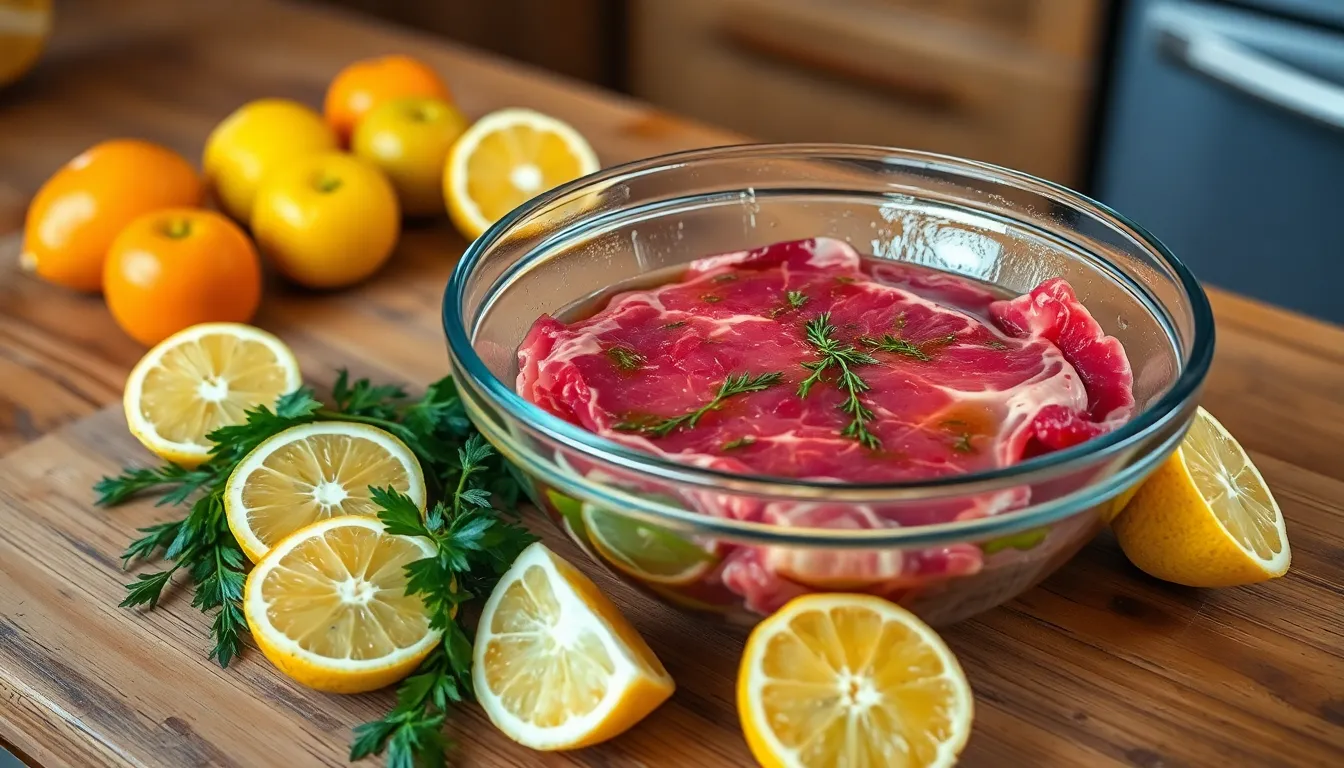
With our flavorful marinade ready, we turn our attention to selecting the perfect cut of beef and mastering the marinating process. These crucial steps ensure our carne asada develops maximum flavor and tender texture.
Choosing the Right Cut
We recommend three exceptional cuts for authentic carne asada: skirt steak, flank steak, or flap steak. These cuts deliver outstanding flavor and possess the ideal texture and marbling for high-heat grilling. Skirt steak stands as our top choice due to its robust beefy taste and ability to absorb marinades effectively.
Before marinating, we trim excess fat from the steak to prevent flare-ups during grilling. The natural grain structure of these cuts allows the marinade to penetrate deeply, creating tender and flavorful results. Each cut offers excellent value while delivering restaurant-quality taste when prepared properly.
Marinating Time and Tips
We achieve optimal results by marinating our beef for 4 to 6 hours, allowing the citrus acids and spices to tenderize the meat without breaking down its structure. The following marinating timeline ensures perfect texture and flavor development:
| Marinating Duration | Result |
|---|---|
| 1 hour minimum | Basic flavor infusion |
| 1-4 hours | Optimal tenderness and flavor |
| 4-8 hours | Maximum flavor development |
| Beyond 8 hours | Risk of mushy texture |
We use a non-reactive container made of glass or plastic to prevent any metallic taste from developing. The steak must be completely coated with marinade, and we turn it occasionally during the marinating process to ensure even coverage.
Proper refrigeration maintains food safety while the marinade works its magic. We cover the container tightly to prevent contamination and preserve the fresh flavors of our citrus and herb blend. This careful attention to marinating time and technique transforms ordinary cuts of beef into extraordinary carne asada.
Grilling Instructions
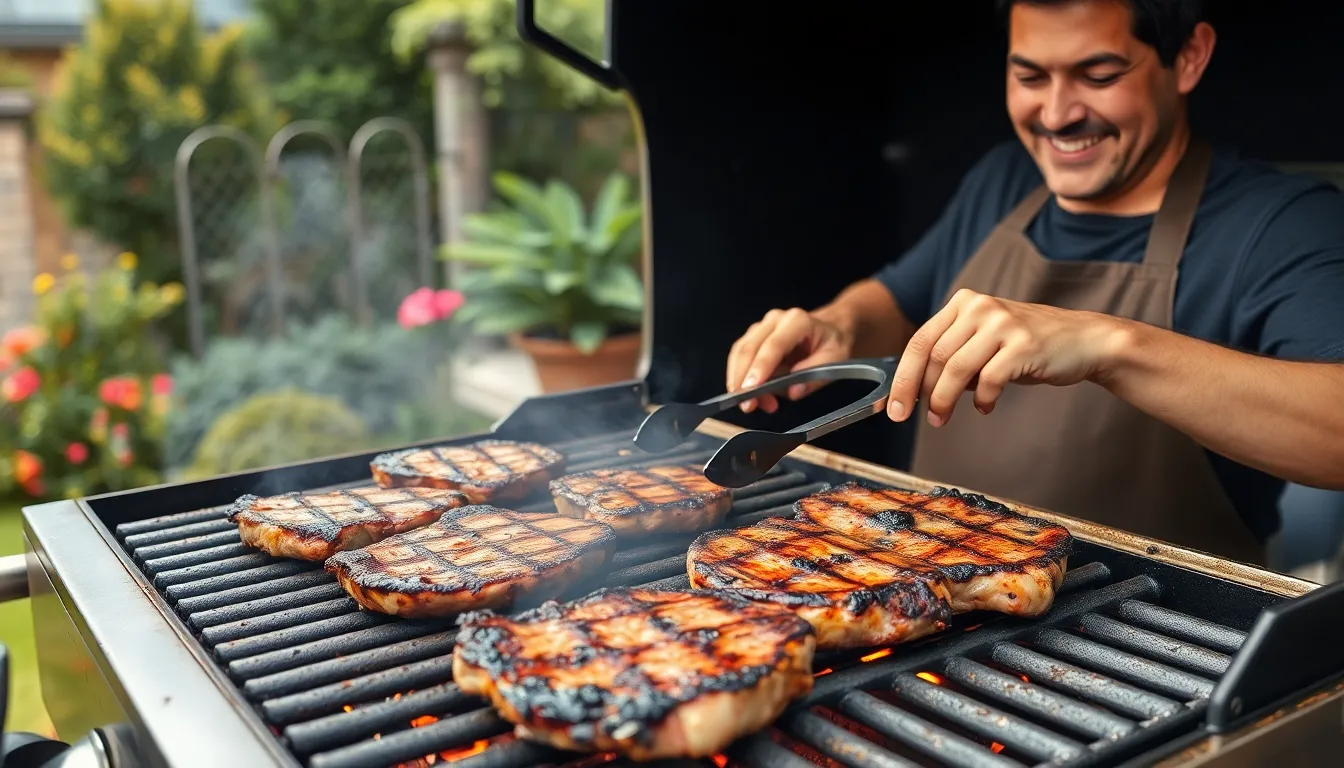
Our marinated beef is ready to transform into smoky perfection through proper grilling technique. We’ll achieve that signature charred exterior and juicy interior by following these essential steps.
Prep the Grill
We start by preheating our outdoor grill to medium-high heat for optimal searing. Clean grill grates thoroughly to remove any residue from previous cooking sessions. Oil the grates generously using a paper towel dipped in vegetable oil to prevent our carne asada from sticking. This preparation step ensures even cooking and makes flipping the meat effortless.
Cooking the Beef
We remove the steak from its marinade and let excess liquid drip off completely before placing it on the hot grill. Position the meat directly over the heat source for maximum char development. Grill flank steak for 5 to 7 minutes per side while skirt steak requires 7 to 10 minutes per side due to its thickness variation. Avoid moving or pressing the meat during cooking to allow proper caramelization and grill marks to form.
Checking for Doneness
We use an instant-read meat thermometer inserted into the thickest part of the steak to ensure accuracy. Target internal temperatures range from 125°F to 130°F for medium-rare or 130°F to 140°F for medium doneness. Our total cooking time typically spans 10 to 15 minutes depending on steak thickness and desired doneness level.
| Doneness Level | Internal Temperature | Cooking Time |
|---|---|---|
| Medium-rare | 125°F to 130°F | 10-12 minutes |
| Medium | 130°F to 140°F | 12-15 minutes |
We remove the steak from the grill once it reaches our preferred temperature and allow it to rest for 5 minutes before slicing. This resting period redistributes juices throughout the meat for maximum tenderness and flavor.
Resting and Slicing
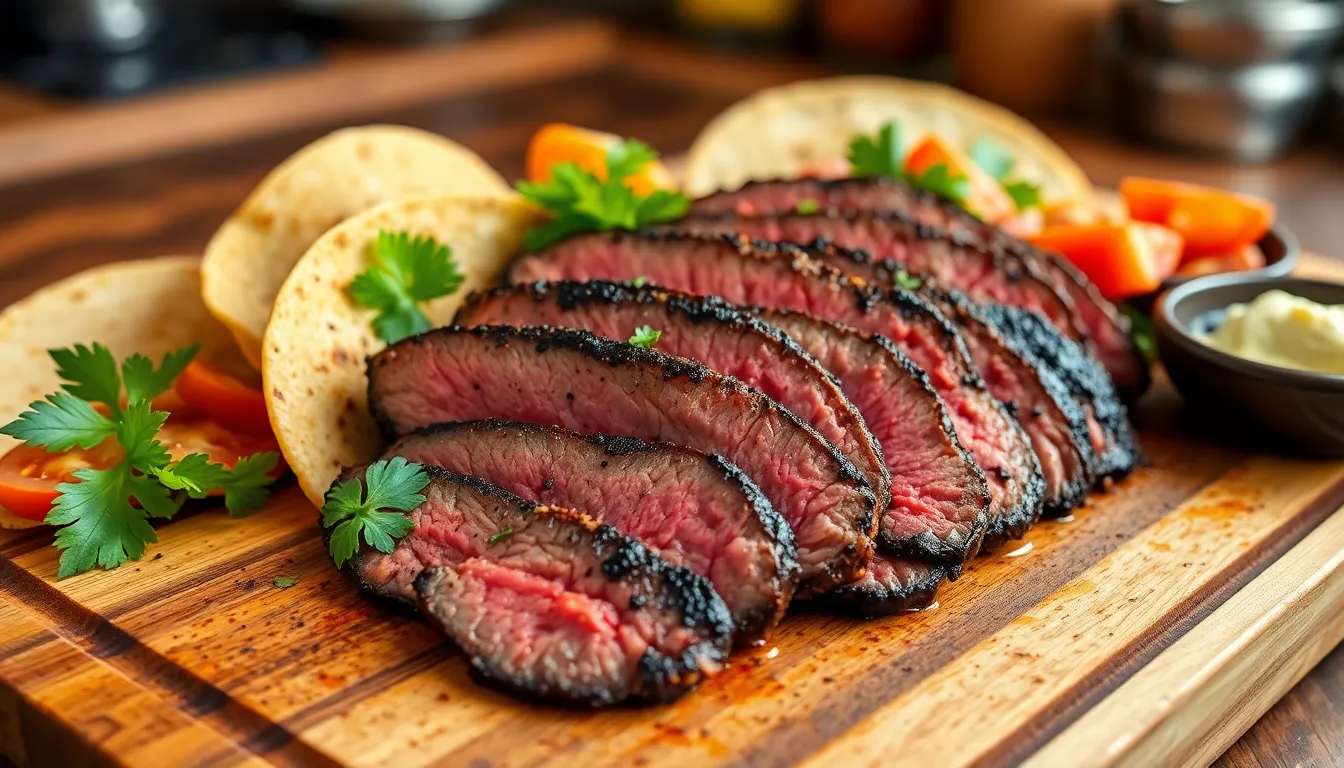
After we remove our perfectly grilled carne asada from the heat, we must resist the temptation to slice it immediately. Resting the beef for 5 to 10 minutes allows the juices to redistribute throughout the meat, transforming what could be a dry disappointment into juicy, tender perfection. We cover the steak loosely with aluminum foil during this crucial waiting period to maintain warmth while the internal juices settle.
The resting phase serves as our final opportunity to ensure maximum tenderness and flavor retention. During cooking, heat forces the meat’s juices toward the center, and cutting too early causes these precious juices to spill onto our cutting board rather than staying within the beef. We use this time to prepare our serving accompaniments or warm our tortillas.
Once our carne asada has properly rested, we focus on the critical slicing technique that separates good carne asada from exceptional results. We position our sharp knife perpendicular to the muscle fibers, which run in long lines across the meat’s surface. Slicing across the grain breaks up these tough muscle fibers, ensuring each bite delivers maximum tenderness and easier chewing.
We cut the beef into thin slices, approximately 1/4 to 1/2 inch thick, maintaining consistent thickness for even texture throughout our serving portions. Each slice should showcase the beautiful char on the exterior while revealing the perfectly cooked interior. The grain direction becomes most visible on flank steak, where muscle fibers create distinct parallel lines that guide our cutting angle.
Our slicing technique directly impacts the final eating experience, transforming what could be chewy beef into tender, flavorful strips perfect for tacos, burritos, or standalone serving. We arrange the sliced carne asada on our serving platter immediately after cutting to preserve warmth and present the appealing contrast between the caramelized exterior and succulent interior.
Serving Suggestions
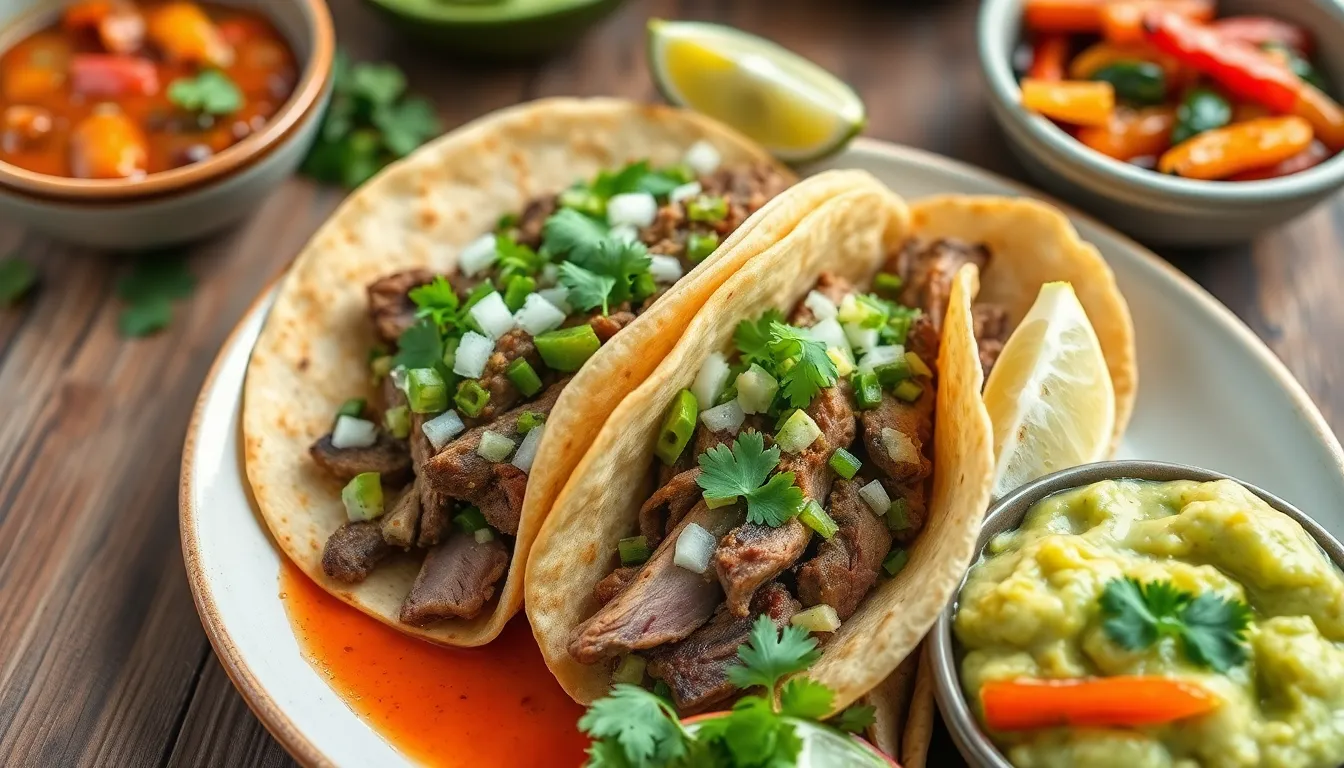
Our perfectly grilled carne asada transforms into an unforgettable meal when paired with the right accompaniments and presentation. We’ll explore traditional Mexican pairings and authentic taco assembly techniques to maximize the flavors of our marinated beef.
Traditional Accompaniments
Fresh tortillas form the foundation of authentic carne asada service. We recommend warming corn tortillas directly on the grill grates or stovetop for 30 seconds per side until they develop light char marks and become pliable. Flour tortillas work equally well when heated in a dry skillet over medium heat.
Salsa elevates every bite with bright acidity and heat. Fresh pico de gallo brings crisp texture with diced tomatoes, onions, cilantro, and jalapeños. Salsa verde adds tangy tomatillo flavor, while smoky chipotle salsa complements the charred beef beautifully.
Guacamole provides creamy richness that balances the beef’s bold flavors. We mash ripe avocados with lime juice, minced garlic, diced onions, and fresh cilantro for the perfect consistency.
Lime wedges offer essential brightness when squeezed fresh over each serving. The citrus cuts through the meat’s richness and enhances the marinade’s citrus notes.
Mexican rice and refried beans create hearty sides that complete the meal. Grilled vegetables like bell peppers, onions, and zucchini add colorful nutrition and smoky flavors that complement our carne asada.
Radishes and pickled jalapeños provide crucial textural contrast with their crisp bite and acidic punch. These traditional garnishes cut through the beef’s richness while adding authentic Mexican flavors.
Taco Assembly
Start by warming corn tortillas on the grill or stovetop until they become soft and slightly charred. Place 3 to 4 ounces of our sliced carne asada down the center of each tortilla, ensuring the meat stays warm for optimal flavor.
Top the beef with finely chopped white onions and fresh cilantro leaves. These classic garnishes provide sharp onion bite and herbaceous freshness that enhance the beef without overwhelming its flavor.
Add one spoonful of your chosen salsa or a dollop of guacamole for moisture and complementary flavors. We avoid overloading tacos to maintain the proper balance between meat and accompaniments.
Squeeze fresh lime juice generously over the assembled taco. The citrus brightness awakens all the flavors and provides the authentic finishing touch that defines great carne asada tacos.
Optional additions include crumbled queso fresco, Mexican crema, or a sprinkle of cotija cheese for added richness. Pickled red onions or jalapeños can provide extra tang and heat for those who prefer bolder flavors.
Serve immediately while the tortillas remain warm and the beef retains its optimal temperature for the most authentic carne asada taco experience.
Storage and Reheating
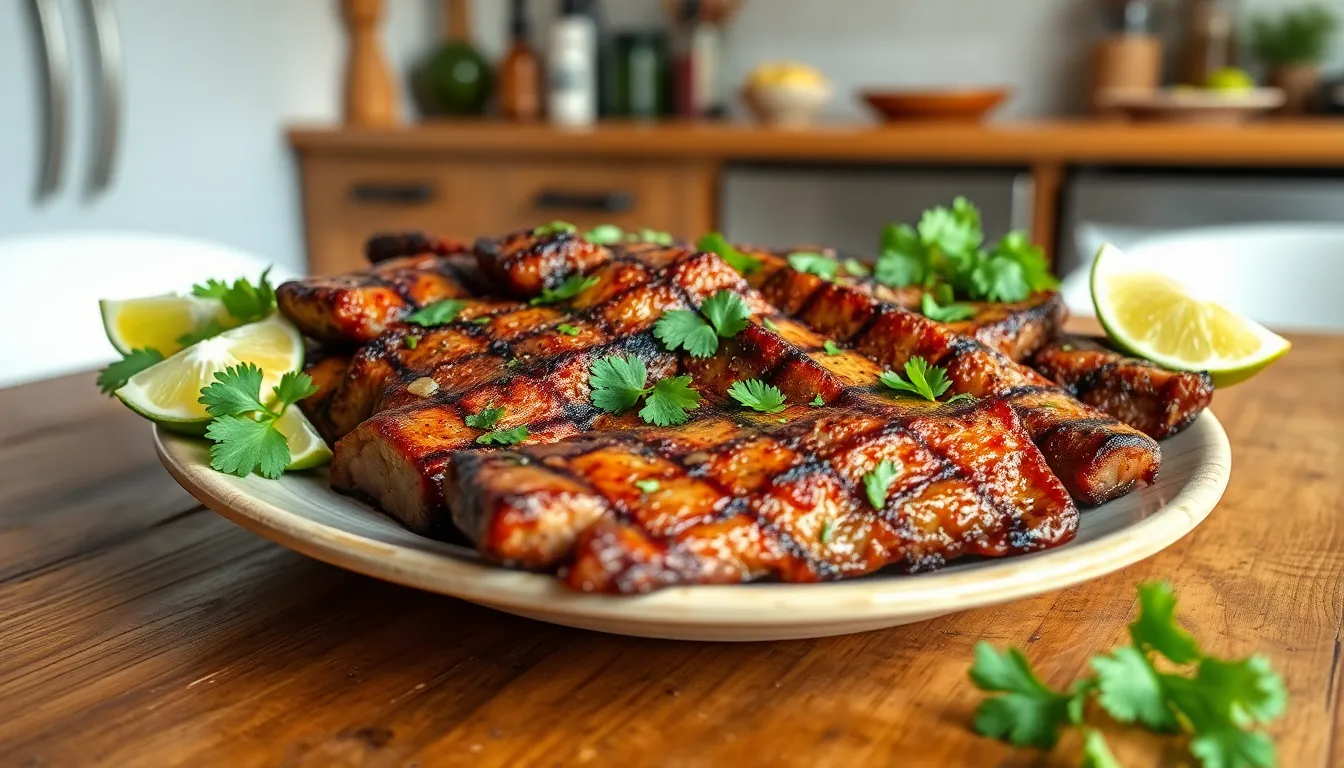
Proper storage extends the life of our perfectly grilled carne asada while maintaining its authentic flavors and tender texture. We recommend storing leftover carne asada in an airtight container in the refrigerator where it stays fresh for up to 3-4 days. For longer storage needs, we can freeze the cooked sliced steak in a freezer-safe container or bag for up to 2-3 months.
| Storage Method | Duration | Container Type |
|---|---|---|
| Refrigerator | 3-4 days | Airtight container |
| Freezer | 2-3 months | Freezer-safe container or bag |
Reheating carne asada requires gentle methods to preserve the meat’s juiciness and prevent it from drying out. We achieve the best results by reheating slices in a skillet over medium heat with a splash of water or broth to maintain moisture. Covering the skillet with a lid during this process helps trap steam and keeps the meat tender.
Microwave reheating works well when we use medium power settings in short bursts while keeping the meat covered to retain moisture. This method prevents the common mistake of overheating which can make our carne asada tough and dry.
Avoiding overheating becomes crucial regardless of the reheating method we choose. The goal is to warm the meat through while preserving the tenderness and flavor that makes carne asada special. Restoring moisture during the reheating process helps maintain the juicy texture that characterizes authentic carne asada.
We find that adding a small amount of the original marinade or a splash of lime juice during reheating can refresh the flavors and bring back some of the vibrant taste from when it was freshly grilled.
Tips for Perfect Carne Asada
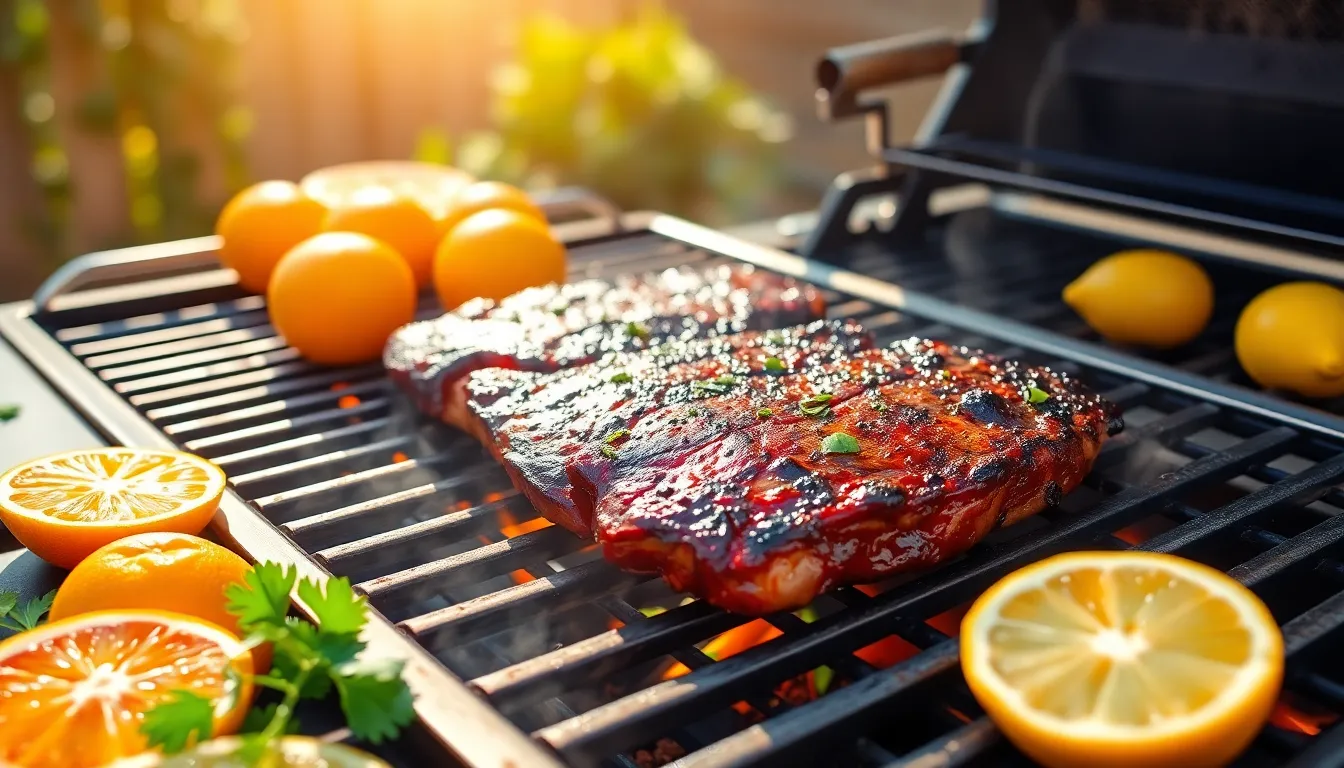
Mastering the art of carne asada requires attention to detail and understanding the subtle techniques that transform ordinary beef into extraordinary Mexican street food. We’ve gathered the most effective methods to ensure your carne asada achieves that perfect balance of smoky char and tender interior.
Choose the Right Cut
Skirt steak remains our top recommendation for authentic carne asada due to its ideal fat content and texture. Flank steak offers a buttery flavor and works exceptionally well as an alternative option. Both cuts absorb marinades beautifully and cook quickly over high heat.
Master the Marinating Process
Citrus juices from orange, lime, and lemon work together with apple cider vinegar to naturally tenderize the beef while infusing it with bright flavors. Fresh cilantro and ground cumin provide the classic seasoning profile that defines authentic carne asada. We recommend marinating for 4 to 6 hours maximum to avoid over-tenderizing the meat, which can result in a mushy texture.
Prepare Your Meat Properly
Pounding the steak to an even thickness ensures uniform cooking throughout and creates additional tenderness. Trimming excess fat prevents dangerous flare-ups on the grill while maintaining the meat’s natural juices. After marinating, apply a wet spice rub made from the marinade spices mixed with olive oil for extra flavor and an appealing crust.
Perfect Your Cooking Technique
| Cooking Method | Temperature | Time Per Side |
|---|---|---|
| Grilling | Medium-high | 7-10 minutes |
| Broiler | High | 4-8 minutes |
| Stovetop | Medium-high | 4-8 minutes |
Monitor internal temperatures carefully to achieve your desired doneness. We aim for 130-140°F for medium-rare or 140-150°F for medium. Using an instant-read thermometer eliminates guesswork and prevents overcooking.
Allow Proper Resting
Resting the steak for 5 to 10 minutes after cooking allows juices to redistribute throughout the meat, resulting in maximum tenderness and flavor. Cover the meat loosely with aluminum foil during this crucial step to maintain warmth while preventing moisture loss.
Slice Against the Grain
Cutting thin slices against the grain breaks down the muscle fibers and ensures every bite remains tender. This technique is absolutely essential for achieving the authentic texture that makes carne asada so enjoyable. Keep your knife sharp and slice consistently for the best presentation and eating experience.
Conclusion
We’ve shown you that creating authentic carne asada at home doesn’t require professional chef skills or expensive equipment. With the right cut of beef and our proven marinade recipe you’ll achieve that perfect balance of smoky char and tender juiciness that makes this dish so irresistible.
The key lies in the details – choosing quality skirt or flank steak proper marinating time and mastering the high-heat grilling technique. Don’t forget those crucial final steps of resting the meat and slicing against the grain for maximum tenderness.
Whether you’re planning your next backyard barbecue or craving an authentic Mexican meal our carne asada recipe delivers restaurant-quality results every time. Gather your favorite toppings fire up that grill and get ready to enjoy one of Mexico’s most beloved culinary treasures right from your own kitchen.
Frequently Asked Questions
What is carne asada?
Carne asada translates to “grilled meat” in Spanish and is a beloved Mexican street food. It features marinated beef, typically skirt or flank steak, that’s cooked over high heat to achieve a charred exterior and juicy interior. This dish originated in northern Mexico where ranchers grilled beef over open flames and has since become a staple in Mexican and Tex-Mex cuisine.
What cut of beef is best for carne asada?
Skirt steak is the top choice for carne asada due to its excellent fat content and texture that absorbs marinades well. Flank steak serves as a great alternative, offering similar results. Both cuts are affordable, cook quickly over high heat, and become incredibly tender when sliced against the grain after cooking.
How long should I marinate carne asada?
The optimal marinating time for carne asada is 4 to 6 hours. This timeframe allows the citrus-based marinade to tenderize the meat and infuse it with flavor without breaking down the protein structure. Always marinate in the refrigerator using a non-reactive container like a sealed plastic bag or glass dish.
What temperature should I cook carne asada to?
For medium-rare carne asada, cook to an internal temperature of 130-135°F. For medium doneness, aim for 135-145°F. Use an instant-read thermometer to monitor temperature accurately. Cook over medium-high heat, allowing proper caramelization without moving the steak during the initial cooking phase to develop that signature charred exterior.
How do I slice carne asada properly?
Always slice carne asada against the grain to ensure maximum tenderness. Look for the direction of the muscle fibers and cut perpendicular to them. Make thin, consistent slices about ¼-inch thick. This technique breaks up the muscle fibers, making the meat easier to chew and enhancing the overall eating experience.
What are the best accompaniments for carne asada?
Traditional accompaniments include warm corn or flour tortillas, fresh salsas like pico de gallo and salsa verde, guacamole, lime wedges, and chopped cilantro and onions. For heartier sides, serve with Mexican rice, refried beans, or grilled vegetables. These accompaniments complement the smoky, citrusy flavors of the carne asada perfectly.
How do I store and reheat leftover carne asada?
Store leftover carne asada in an airtight container in the refrigerator for 3-4 days or freeze for 2-3 months. For reheating, use gentle methods to preserve juiciness: heat in a skillet over medium heat with a splash of water or broth, or microwave on medium power in short bursts while covered. Avoid overheating to maintain tenderness.
What equipment do I need to make carne asada?
Essential tools include a meat mallet for tenderizing, a large sealable bag for marinating, a whisk for mixing marinade, an instant-read thermometer, a grill or grill pan, tongs for handling, and a sharp knife for slicing. These tools work together to ensure consistent cooking and maximum flavor, helping you achieve restaurant-quality results at home.

